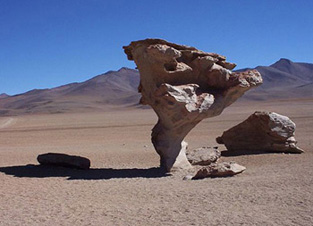Weathering
Look at these two images—one is a sculpture of Abraham Lincoln and one is a natural rock sculpture. How do you think each of these sculptures was formed? Roll over each image to find out more.
Just as the artist uses tools, like chisels and hammers, to whittle away a block of marble into a statue of Lincoln, nature uses water, wind, ice, or other climatic factors to shape its sculptures. Like the marble in the statue, Earth materials are broken down into smaller pieces.
Weathering is said to be an in situ process--meaning it takes place without transporting materials from one place to another. All weathering takes place near Earth’s surface. The atmosphere is the "artist" of all weathering on Earth. In weathering, the atmosphere usually interacts directly with rocks (such as wind directly shaping a rock by constantly beating against it). Sometimes, however, the atmosphere plays a more secondary role, such as when plants produce chemicals to speed up the weathering of rocks. These plants could only survive with the atmosphere around them.

